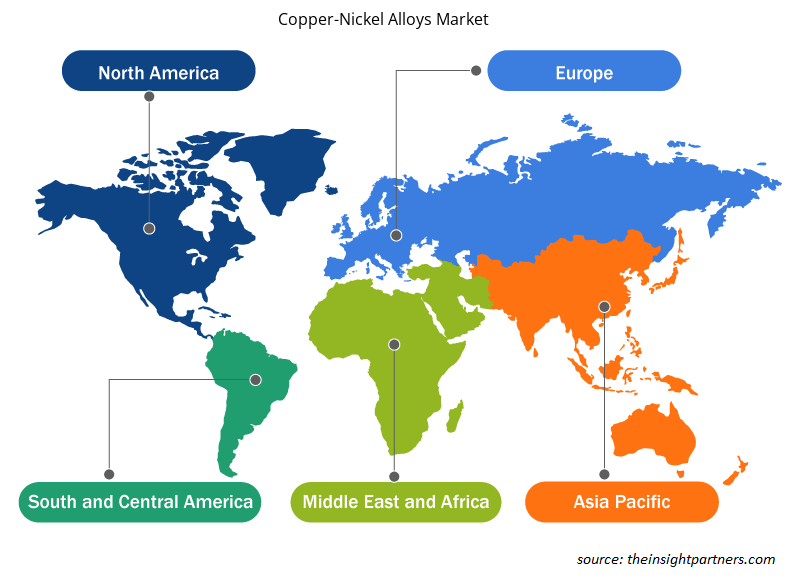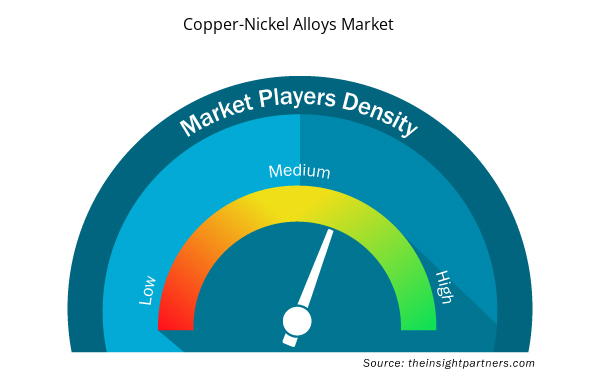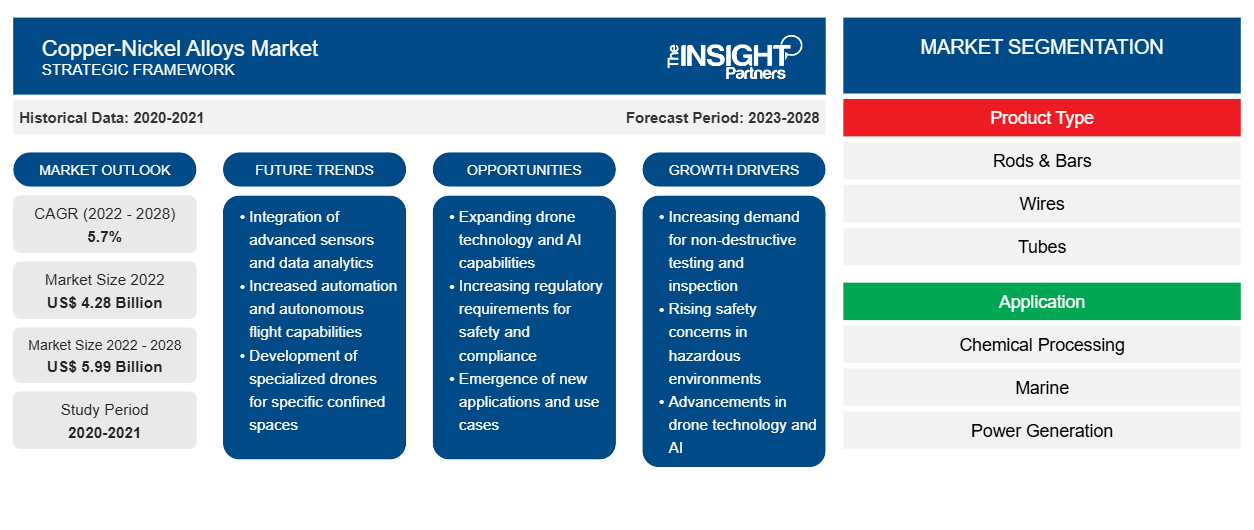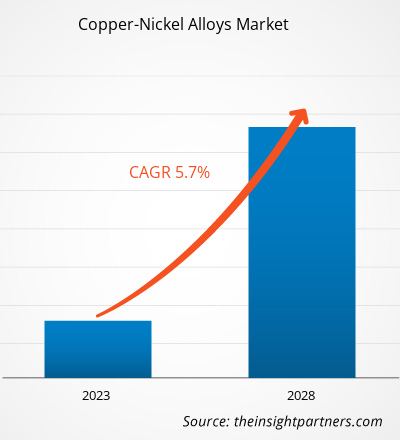Se proyecta que el tamaño del mercado de aleaciones de cobre y níquel será de US$ 5.989,37 millones para 2028; se espera que crezca a una tasa de crecimiento anual compuesta (CAGR) del 5,7 % entre 2022 y 2028.
Las aleaciones de cobre-níquel tienen una excelente resistencia a la corrosión. También presentan resistencia a la macroincrustación debido a la formación de una capa protectora de óxido en sus superficies. Las aleaciones de cobre-níquel suelen presentarse en dos variedades: Cu-Ni (90-10) y Cu-Ni (70-30). La aleación Cu-Ni (70-30) es más fuerte y tiene mayor resistencia a la corrosión (causada por el agua de mar) y a la macroincrustación que la Cu-Ni (70-30). Sin embargo, la Cu-Ni (90-10) es más asequible que la Cu-Ni (70-30) y tiene una mejor vida útil en muchas aplicaciones de uso final. Las aleaciones de cobre-níquel están experimentando una fuerte demanda en las industrias marina, de procesamiento químico, de generación de energía y de petróleo y gas, lo que impulsa principalmente el crecimiento del mercado de aleaciones de cobre-níquel .
Personalice este informe según sus necesidades
Obtendrá personalización en cualquier informe, sin cargo, incluidas partes de este informe o análisis a nivel de país, paquete de datos de Excel, así como también grandes ofertas y descuentos para empresas emergentes y universidades.
- Obtenga las principales tendencias clave del mercado de este informe.Esta muestra GRATUITA incluirá análisis de datos, desde tendencias del mercado hasta estimaciones y pronósticos.
Impacto de la pandemia de COVID-19 en el mercado de aleaciones de cobre y níquel
Las restricciones sociales y comerciales impuestas por los gobiernos al inicio de la pandemia de COVID-19 provocaron una caída significativa de las cadenas de suministro, incluidas las operaciones de importación y exportación, lo que afectó a los precios de las materias primas y obstaculizó las operaciones de la industria de la construcción naval. La industria del petróleo y el gas también experimentó impactos similares de la pandemia, ya que hubo una caída sin precedentes en la demanda de petróleo crudo en 2020, lo que resultó en una disminución significativa de sus precios. Según la Oficina de Estadísticas Laborales, en 2020, la demanda de petróleo disminuyó en 3 millones de barriles por día, lo que representa aproximadamente el 20% del consumo total de petróleo de los EE. UU. Por lo tanto, el grave impacto de la pandemia de COVID-19 en las industrias marítima y de petróleo y gas afectó negativamente a la demanda de aleaciones de cobre y níquel. Además, debido al cierre de las unidades de fabricación, se suspendió la producción de aleaciones de cobre y níquel, lo que obstaculizó la rentabilidad de los fabricantes a pequeña y gran escala.
En 2021, los gobiernos de varios países anunciaron flexibilizaciones de las restricciones impuestas anteriormente y permitieron a los fabricantes operar a plena capacidad. Como resultado, los fabricantes de aleaciones de cobre y níquel revisaron sus estrategias para aumentar su producción, lo que se espera que supere el déficit de producción y la brecha entre la oferta y la demanda. Se espera que este factor impulse el mercado mundial de aleaciones de cobre y níquel durante el período de pronóstico.
Perspectivas del mercado
El aumento en la adopción de aleaciones de cobre y níquel en proyectos de energía renovable generará nuevas tendencias de crecimiento en el mercado de aleaciones de cobre y níquel
Los gobiernos de varios países están alentando a las personas a utilizar fuentes de energía renovables para reducir el impacto ambiental general. Las turbinas, las paletas, los intercambiadores de calor (en los sistemas de energía solar concentrada CSP), las turbinas de energía eólica y muchos componentes utilizados en la generación de energía renovable están hechos de aleaciones de cobre y níquel. Según la Agencia Internacional de la Energía (AIE), el uso de energía renovable aumentó un 3% a nivel mundial en 2020. La proporción de generación de energía mundial a través de fuentes de energía renovable alcanzó el 29% en 2020 desde el 27% en 2019. Estados Unidos, la Unión Europea (UE), China e India, entre otros países, están tomando diversas iniciativas para impulsar las inversiones en la producción de energía limpia para la conservación del medio ambiente y el desarrollo económico sostenible. Por ejemplo, en marzo de 2022, la Unión Europea ideó el "Plan REPowerEU" para producir energía limpia y ahorrar energía para evitar la dependencia de las fuentes de combustibles fósiles rusas. El Plan RePowerEU tiene como objetivo alcanzar una producción total de energía renovable de 1.236 gigavatios para 2030. La Comisión Europea afirmó que la implementación del plan REPowerEU, durante 2022-2027, requeriría una inversión adicional de 208.910 millones de dólares, que espera obtener de los estados miembros de la UE y del sector privado. Se espera que este tipo de iniciativas gubernamentales en diferentes países impulsen el sector de la energía renovable en el futuro, lo que a su vez impulsará el crecimiento del mercado de aleaciones de cobre y níquel.
Información sobre el tipo de producto
Según el tipo de producto, el mercado mundial de aleaciones de cobre y níquel se ha segmentado en varillas y barras, alambres, tubos y otros. El segmento de varillas y barras tuvo la mayor participación de mercado en el mercado en 2021. Las barras redondas de cobre y níquel se utilizan en direcciones asistidas, líneas de freno, tubos de destiladores, placas de condensadores y recipientes a presión debido a sus propiedades únicas, como resistencia a la macroincrustación, buena resistencia a la tracción y resistencia a la corrosión. Además, las varillas de cobre y níquel con un 10% y un 30% de níquel se emplean comúnmente en condensadores, destiladores, evaporadores, tubos de intercambiadores de calor, válvulas mecanizadas y forjadas y piezas de bombas utilizadas para servicios de agua de mar.
Corrotherm International Ltd, Fisk Alloy Inc, Lebronze Alloys SAS, Materion Corp, Aesteiron Steels LLP, Columbia Metals Ltd, American Elements Inc, Hexion Steel Ltd, Aviva Metals Inc y Kalikund Steel and Engg Co se encuentran entre los principales actores que operan en el mercado global de aleaciones de cobre y níquel. Las empresas de este mercado se centran continuamente en estrategias como las inversiones en actividades de investigación y desarrollo y el lanzamiento de nuevos productos.
Perspectivas regionales del mercado de aleaciones de cobre y níquel
Los analistas de Insight Partners explicaron en detalle las tendencias y los factores regionales que influyen en el mercado de aleaciones de cobre y níquel durante el período de pronóstico. Esta sección también analiza los segmentos y la geografía del mercado de aleaciones de cobre y níquel en América del Norte, Europa, Asia Pacífico, Oriente Medio y África, y América del Sur y Central.

- Obtenga datos regionales específicos para el mercado de aleaciones de cobre y níquel
Alcance del informe de mercado de aleaciones de cobre y níquel
| Atributo del informe | Detalles |
|---|---|
| Tamaño del mercado en 2022 | US$ 4.28 mil millones |
| Tamaño del mercado en 2028 | 5.99 mil millones de dólares estadounidenses |
| CAGR global (2022-2028) | 5,7% |
| Datos históricos | 2020-2021 |
| Período de pronóstico | 2023-2028 |
| Segmentos cubiertos | Por tipo de producto
|
| Regiones y países cubiertos | América del norte
|
| Líderes del mercado y perfiles de empresas clave |
|
Densidad de actores del mercado de aleaciones de cobre y níquel: comprensión de su impacto en la dinámica empresarial
El mercado de aleaciones de cobre y níquel está creciendo rápidamente, impulsado por la creciente demanda de los usuarios finales debido a factores como la evolución de las preferencias de los consumidores, los avances tecnológicos y una mayor conciencia de los beneficios del producto. A medida que aumenta la demanda, las empresas amplían sus ofertas, innovan para satisfacer las necesidades de los consumidores y aprovechan las tendencias emergentes, lo que impulsa aún más el crecimiento del mercado.
La densidad de actores del mercado se refiere a la distribución de las empresas o firmas que operan dentro de un mercado o industria en particular. Indica cuántos competidores (actores del mercado) están presentes en un espacio de mercado determinado en relación con su tamaño o valor total de mercado.
Las principales empresas que operan en el mercado de aleaciones de cobre y níquel son:
- Corrotherm Internacional Ltd.
- Aleación Fisk Inc.
- Aleaciones Lebronze SAS
- Corporación Materion.
- Aceros Aesteiron LLP
Descargo de responsabilidad : Las empresas enumeradas anteriormente no están clasificadas en ningún orden particular.

- Obtenga una descripción general de los principales actores clave del mercado de aleaciones de cobre y níquel
Informe Destacado
- Tendencias progresivas de la industria en el mercado de aleaciones de cobre y níquel para ayudar a los actores a desarrollar estrategias efectivas a largo plazo
- Estrategias de crecimiento empresarial adoptadas por las empresas para proliferar en mercados desarrollados y en desarrollo
- Análisis cuantitativo del mercado de aleaciones de cobre y níquel de 2020 a 2028
- Estimación de la demanda mundial de aleaciones de cobre y níquel
- Análisis de las cinco fuerzas de Porter para ilustrar la eficacia de los compradores y proveedores en la industria
- Avances recientes para comprender el escenario competitivo del mercado
- Tendencias y perspectivas del mercado, impulsores y restricciones en el mercado de aleaciones de cobre y níquel
- Asistencia en el proceso de toma de decisiones destacando las estrategias de mercado que sustentan el interés comercial.
- Tamaño del mercado de aleaciones de cobre y níquel en varios nodos
- Descripción detallada y segmentación del mercado, así como la dinámica de la industria de aleaciones de cobre y níquel.
- Tamaño del mercado de aleaciones de cobre y níquel en diversas regiones con prometedoras oportunidades de crecimiento
Perfiles de empresas
- Corrotherm Internacional Ltd.
- Aleación Fisk Inc.
- Aleaciones Lebronze SAS
- Corporación Materion
- Aceros Aesteiron LLP
- Metales de Columbia Ltd.
- Elementos americanos inc.
- Hexion Steel Ltd
- Aviva Metals Inc
- Compañía de acero e ingeniería Kalikund
- Análisis histórico (2 años), año base, pronóstico (7 años) con CAGR
- Análisis PEST y FODA
- Tamaño del mercado Valor/volumen: global, regional, nacional
- Industria y panorama competitivo
- Conjunto de datos de Excel


- Emergency Department Information System (EDIS) Market
- Aircraft Wire and Cable Market
- Ceiling Fans Market
- Fixed-Base Operator Market
- Workwear Market
- Antibiotics Market
- Pharmacovigilance and Drug Safety Software Market
- Procedure Trays Market
- Toothpaste Market
- Artificial Intelligence in Healthcare Diagnosis Market

Report Coverage
Revenue forecast, Company Analysis, Industry landscape, Growth factors, and Trends

Segment Covered
This text is related
to segments covered.

Regional Scope
North America, Europe, Asia Pacific, Middle East & Africa, South & Central America

Country Scope
This text is related
to country scope.
Preguntas frecuentes
Based on the application, marine segment is projected to register the highest CAGR over the forecast period. In recent years, the use of copper-nickel tubes has been extended to hydraulic and instrumentation systems, which have become increasingly important in the operations of ship and offshore platform control and monitoring systems. The copper-nickel alloys offer excellent resistance to saltwater corrosion, ensuring a highly reliable system.
Widespread applications of copper-nickel alloys is driving the copper-nickel alloys market growth. Copper-nickel alloys are used in various industries, including shipbuilding, oil & gas, aerospace, automotive, paper & pulp, and food & beverages. In the marine industry, the alloys are used to fabricate components and pipe fittings for ships and seagoing vessels. As copper-nickel alloys withstand high corrosion rates, they are extensively used as sheathing on oil and gas platforms. Moreover, the alloys are used in floating production storage and offloading (FPSO) vessels in the offshore oil & gas industry.
Asia Pacific accounted for the largest share of the global copper-nickel alloys market. The continued economic growth and urbanization of the region require developing reliable and affordable energy systems with significant additional electricity-generating capacity. According to the International Energy Agency, the installed electricity-generating capacity of the region is expected to rise by approximately 7% per annum, from 3,386 GW in 2019 to 6,113 GW by 2030. In addition, the amount of investment in renewable energy production across the region is expected to reach US$ 1.3 trillion per annum by 2030.
Based on product type, rods & bars segments mainly have the largest revenue share. Copper-nickel bars are an alloy of copper, nickel, and other strengthening elements such as manganese and iron. Copper-nickel round bars are used in power steering, brake lines, distiller tubes, condenser plates, and pressure vessels. Owing to their unique properties such as resistance to macro fouling, good tensile strength, and corrosion resistance, the round bars are specified for shipbuilding and repair, desalination plants, offshore oil and gas structures, power generation, and other marine engineering applications. Further, copper-nickel rods with 10% and 30% nickel are commonly employed for condensers, distillers, evaporators, heat exchanger tubes, machined and forged valves, and pump parts used for seawater services. The rods are highly corrosion-resistant to salt water, which is helpful for heat exchangers and condensers in seawater systems.
The major players operating in the global copper-nickel alloys market are Corrotherm International Ltd.; Fisk Alloy Inc.; Lebronze Alloys SAS; Materion Corp.; Aesteiron Steels LLP; Columbia Metals Ltd.; American Elements Inc.; Hexican Steel Ltd.; Aviva Metals Inc.; Kalikund Steel and Engg. Co.
Presence of large-desalination plants in the Middle East and Africa is anticipated to offer lucrative growth opportunities for the copper-nickel alloys market. Copper-nickel alloys have excellent corrosion resistance. Copper-nickel alloys are widely used in multi-stage flash distillation (MSF) and multiple-effect distillation (MED) desalination plants to provide high corrosion resistance to heat exchangers and other components, including tubeplate, water boxes, pipe fittings, and evaporator shells. When seawater is fed to the desalination system, it causes corrosion of metal components, which can reduce the lifespan of the total system. Therefore, copper-nickel alloys are used in desalination systems. Thus, the presence of a large number of desalination plants in the Middle East & Africa is expected to create huge demand for copper-nickel alloys, which would provide lucrative opportunities for the market during the forecast period.
Trends and growth analysis reports related to Chemicals and Materials : READ MORE..
The List of Companies - Copper-Nickel Alloys Market
- Corrotherm International Ltd.
- Fisk Alloy Inc.
- Lebronze Alloys SAS
- Materion Corp.
- Aesteiron Steels LLP
- Columbia Metals Ltd.
- American Elements Inc.
- Hexican Steel Ltd.
- Aviva Metals Inc.
- Kalikund Steel and Engg Co.
The Insight Partners performs research in 4 major stages: Data Collection & Secondary Research, Primary Research, Data Analysis and Data Triangulation & Final Review.
- Data Collection and Secondary Research:
As a market research and consulting firm operating from a decade, we have published and advised several client across the globe. First step for any study will start with an assessment of currently available data and insights from existing reports. Further, historical and current market information is collected from Investor Presentations, Annual Reports, SEC Filings, etc., and other information related to company’s performance and market positioning are gathered from Paid Databases (Factiva, Hoovers, and Reuters) and various other publications available in public domain.
Several associations trade associates, technical forums, institutes, societies and organization are accessed to gain technical as well as market related insights through their publications such as research papers, blogs and press releases related to the studies are referred to get cues about the market. Further, white papers, journals, magazines, and other news articles published in last 3 years are scrutinized and analyzed to understand the current market trends.
- Primary Research:
The primarily interview analysis comprise of data obtained from industry participants interview and answers to survey questions gathered by in-house primary team.
For primary research, interviews are conducted with industry experts/CEOs/Marketing Managers/VPs/Subject Matter Experts from both demand and supply side to get a 360-degree view of the market. The primary team conducts several interviews based on the complexity of the markets to understand the various market trends and dynamics which makes research more credible and precise.
A typical research interview fulfils the following functions:
- Provides first-hand information on the market size, market trends, growth trends, competitive landscape, and outlook
- Validates and strengthens in-house secondary research findings
- Develops the analysis team’s expertise and market understanding
Primary research involves email interactions and telephone interviews for each market, category, segment, and sub-segment across geographies. The participants who typically take part in such a process include, but are not limited to:
- Industry participants: VPs, business development managers, market intelligence managers and national sales managers
- Outside experts: Valuation experts, research analysts and key opinion leaders specializing in the electronics and semiconductor industry.
Below is the breakup of our primary respondents by company, designation, and region:

Once we receive the confirmation from primary research sources or primary respondents, we finalize the base year market estimation and forecast the data as per the macroeconomic and microeconomic factors assessed during data collection.
- Data Analysis:
Once data is validated through both secondary as well as primary respondents, we finalize the market estimations by hypothesis formulation and factor analysis at regional and country level.
- Macro-Economic Factor Analysis:
We analyse macroeconomic indicators such the gross domestic product (GDP), increase in the demand for goods and services across industries, technological advancement, regional economic growth, governmental policies, the influence of COVID-19, PEST analysis, and other aspects. This analysis aids in setting benchmarks for various nations/regions and approximating market splits. Additionally, the general trend of the aforementioned components aid in determining the market's development possibilities.
- Country Level Data:
Various factors that are especially aligned to the country are taken into account to determine the market size for a certain area and country, including the presence of vendors, such as headquarters and offices, the country's GDP, demand patterns, and industry growth. To comprehend the market dynamics for the nation, a number of growth variables, inhibitors, application areas, and current market trends are researched. The aforementioned elements aid in determining the country's overall market's growth potential.
- Company Profile:
The “Table of Contents” is formulated by listing and analyzing more than 25 - 30 companies operating in the market ecosystem across geographies. However, we profile only 10 companies as a standard practice in our syndicate reports. These 10 companies comprise leading, emerging, and regional players. Nonetheless, our analysis is not restricted to the 10 listed companies, we also analyze other companies present in the market to develop a holistic view and understand the prevailing trends. The “Company Profiles” section in the report covers key facts, business description, products & services, financial information, SWOT analysis, and key developments. The financial information presented is extracted from the annual reports and official documents of the publicly listed companies. Upon collecting the information for the sections of respective companies, we verify them via various primary sources and then compile the data in respective company profiles. The company level information helps us in deriving the base number as well as in forecasting the market size.
- Developing Base Number:
Aggregation of sales statistics (2020-2022) and macro-economic factor, and other secondary and primary research insights are utilized to arrive at base number and related market shares for 2022. The data gaps are identified in this step and relevant market data is analyzed, collected from paid primary interviews or databases. On finalizing the base year market size, forecasts are developed on the basis of macro-economic, industry and market growth factors and company level analysis.
- Data Triangulation and Final Review:
The market findings and base year market size calculations are validated from supply as well as demand side. Demand side validations are based on macro-economic factor analysis and benchmarks for respective regions and countries. In case of supply side validations, revenues of major companies are estimated (in case not available) based on industry benchmark, approximate number of employees, product portfolio, and primary interviews revenues are gathered. Further revenue from target product/service segment is assessed to avoid overshooting of market statistics. In case of heavy deviations between supply and demand side values, all thes steps are repeated to achieve synchronization.
We follow an iterative model, wherein we share our research findings with Subject Matter Experts (SME’s) and Key Opinion Leaders (KOLs) until consensus view of the market is not formulated – this model negates any drastic deviation in the opinions of experts. Only validated and universally acceptable research findings are quoted in our reports.
We have important check points that we use to validate our research findings – which we call – data triangulation, where we validate the information, we generate from secondary sources with primary interviews and then we re-validate with our internal data bases and Subject matter experts. This comprehensive model enables us to deliver high quality, reliable data in shortest possible time.


 Obtenga una muestra gratuita de este informe
Obtenga una muestra gratuita de este informe